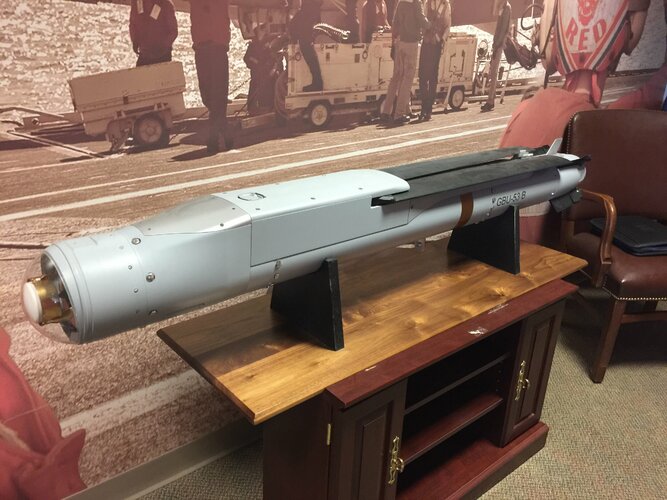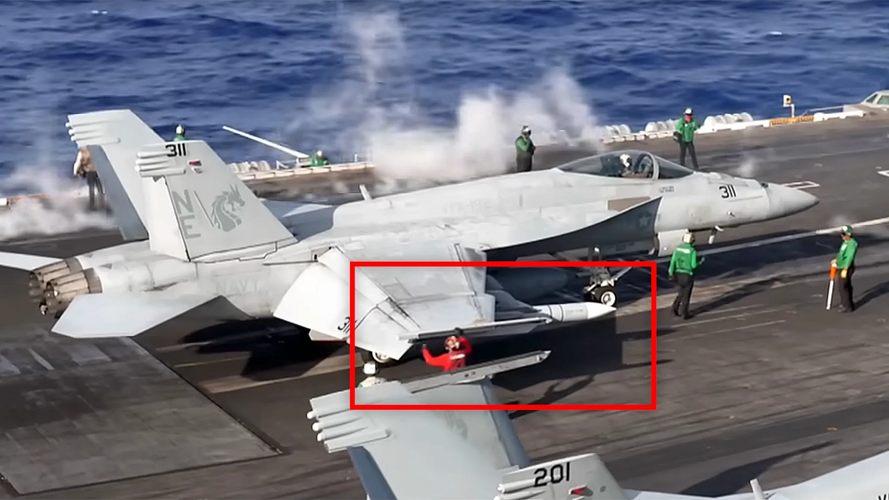kqcke for you
PUMA PUMA PUMA
- Joined
- 3 November 2022
- Messages
- 1,270
- Reaction score
- 1,669
68" are 1.7272m. I Said 1.72m close enoughThe Mk-72 booster is 68" long.
68" are 1.7272m. I Said 1.72m close enoughThe Mk-72 booster is 68" long.
No firm answer that I could find, but at least 1488lbs (SLAM-ER).
Nice!No firm answer that I could find, but at least 1488lbs (SLAM-ER).
Belongs here:In the recent exercise Valiant Shield a SM-6 intercept was guided by the prototype LTAMDS radar and the IBCS BMC, no mention was made of how far away was the Burke when it launched the SM-6 from the land based systems and the target.
https://www.defensenews.com/pentago...target-using-armys-new-missile-defense-radar/
I wonder if the nature of an active radar seeker makes that particular layout unviable. While we've seen SARH missiles with an IR seeker in the nose like that I don't think I've seen/heard of an active-radar homing AAM with the same.The Mk-72 booster is 68" long.
The IIR seeker could be put in the tip of the radome just like on the AIM-7R.

David Sling or more precisely Stunner missile have both.I wonder if the nature of an active radar seeker makes that particular layout unviable. While we've seen SARH missiles with an IR seeker in the nose like that I don't think I've seen/heard of an active-radar homing AAM with the same.
So do the SN6, but that one has it on a wing.David Sling or more precisely Stunner missile have both.
GBU-53/B and SPEAR both have that layout and they both have active MMW seekerI wonder if the nature of an active radar seeker makes that particular layout unviable. While we've seen SARH missiles with an IR seeker in the nose like that I don't think I've seen/heard of an active-radar homing AAM with the same.

Eh, maybe? You'd go from 4 per volume slot to 2. It'd take some serious analysis to convince me that losing half the capacity to gain range is worth it.I'm wondering a turbojet powered version of the SDB-II will be developed?
Eh, maybe? You'd go from 4 per volume slot to 2. It'd take some serious analysis to convince me that losing half the capacity to gain range is worth it.
But it has a smaller warhead so not technically a powered SDB II then unless I'm reading this wrong. Raytheon has previously commented that they are exploring extended range variants of the StormBreaker but there's no current known USAF or Navy program for a munition of that range and class so a lot will depend what the services may want and what that turns out to be might be a lot different than either SDB II or SPEAR.technically speaking, SPEAR fit the bill, it basically SDB II with turbojet engine and smaller warhead
yeah it does, but you got to sacrifice something to put the engine and the fuel there while still keeping the same form factor of the weapons. It would not be possible otherwise. If you make the weapon bigger or longer then this will just reduce the maximum number that an aircraft can carry . And that defeat the main purpose of miniature weapon like SDB II.But it has a smaller warhead so not technically a powered SDB II then unless I'm reading this wrong. Raytheon has previously commented that they are exploring at extended range variants of the StormBreaker but there's no current known USAF or Navy program for a munition of that range and class.


Mere weeks ago, the US Navy put its newest air-to-air missile in service. It’s the biggest and longest-ranged US air-to-air missile ever. For a few years now, the new missile has occasionally been spotted under Super Hornet fighter jets.
Its designation: AIM-174. This video will cover the potential of the new missile and compare it with the now-retired Phoenix missile, the AMRAAM, and China's big air-to-air missile. But even more importantly, this video will explore how the missile might be used and why it is such a big deal for the US near future firepower.
Since the RAAF flies Super Hornets I wonder if it will purchase a batch of AIM-174Bs?
Since the USN has done all of the needed integration work then if the RAAF decides to acquire the AIM-174B then they only need to pay for the missiles, spare-parts and the associated training on how to use and maintain them.
It’s a pricey missile though. I think like $4 mil.
I could see them buying it as a flex missile. It's damn near hypersonic, and one hitting a modern ship will do UGLY things. Less effective versus land targets unless you're talking soft targets like radars and SAM sites, but it's fast to get there. And if it's still under power as it dives down onto the target, it can jink/drunkwalk all the way down. Drunkwalking after burnout means that it burns speed after every maneuver.They probably do not have an operational need. They do not get close to the PLAAF. Although on the other hand, integration presumably is already handled.
I could see them buying it as a flex missile. It's damn near hypersonic, and one hitting a modern ship will do UGLY things. Less effective versus land targets unless you're talking soft targets like radars and SAM sites, but it's fast to get there. And if it's still under power as it dives down onto the target, it can jink/drunkwalk all the way down. Drunkwalking after burnout means that it burns speed after every maneuver.
And if something goes very sideways, they can use it as an AAM.
The ship-launched designation is RIM-174B, and that has all the surface to surface modes included. Not sure what the Typhon-launched designation is, I'm expecting BIM174.Perhaps, but we do not know the extent of the integration. The AIM designation make it pretty clear that the primary role is A2A. We do not know that F-18s can exploit the anti surface modes of the missile, assuming the air launched version retain all the same hardware and software to enable that usage.
No it does not.The AIM designation make it pretty clear that the primary role is A2A.
If that really is the case, how can it be guided? This could potentially show that this project might be a stand-in for an A2G version of the RIM-174, which has been floated about in the pastMillenium 7 estimates the range of the AIM-174 to be 620 km (385 miles)View: https://youtu.be/rhsSlmbnV8I?si=YlKNchxmD1lD68wU
You probably aren't ever shooting it at a target 620 km away. You're probably shooting it at a 400 km target and getting a very high PK. It has an amraam seeker, should be able to guide in on a tanker or AWACS by the time it's lost data link.If that really is the case, how can it be guided? This could potentially show that this project might be a stand-in for an A2G version of the RIM-174, which has been floated about in the past
Just put them on awacsIf that really is the case, how can it be guided? This could potentially show that this project might be a stand-in for an A2G version of the RIM-174, which has been floated about in the past
If that really is the case, how can it be guided? This could potentially show that this project might be a stand-in for an A2G version of the RIM-174, which has been floated about in the past
That range is extrapolated from the estimated max ranges of other very long range AAM. Bigger missile = more range is the assumption. Max range is of course not the same as effective range. Shooting at the absolute max range would give a very low PK so would probably never be employed like that.Some other platform could provide guidance; SM-6 can use offboard platforms like F-35 and E-2D. Though personally I find that range highly suspect. Or super sus, as the kids say.
And who will give him a target designation for such a range, did they say?Millenium 7 estimates the range of the AIM-174 to be 620 km (385 miles)
And who will give him a target designation for such a range, did they say?
And who will give him a target designation for such a range, did they say?
Off-board assets like stealth aircraft, CCAs and FOO Fighter satellites.And who will give him a target designation for such a range, did they say?
